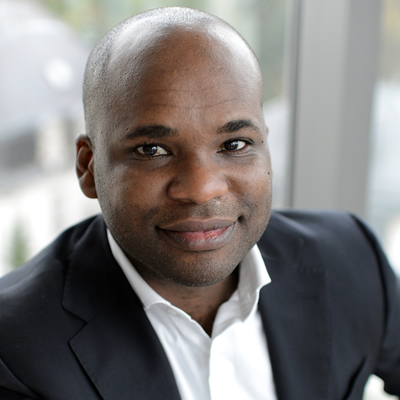Impact: a new dimension gaining traction with investors
While risk is now a well-established notion in management practices, the notion of impact is struggling to spread beyond certain spheres of informed investors; however, it has an undeniable role to play in the construction of a portfolio in the face of current major environmental and social issues.
A dichotomy
In the space of a week, I had the opportunity to attend a seminar on impact investing and a conference on the current situation of emerging market debt.
During the week, I was struck by the extent to which the world of impact investors (foundations, family offices, religious congregations, academia, etc., which I will call ‘World 1’ for the purposes of this analysis) and the world of more traditional investors, to which I belong (let's call it ‘World 2’) seemed to be totally dissociated, if not oblivious to each other. While those in World 1 were talking about humanity’s irreversible entry into the decisive decade to limit climate change as far as possible, those in World 2 were still seeking out the best relative valuations in emerging market debt. A few days later, at a meeting with various managers and advisers from the insurance and fund selection sector, we were discussing how to approach sustainability and impact issues as investors. Here too, I couldn’t fail to notice the difficulty in positively combining the concepts of impact and investment, or rather, impact and performance (or expected return).
The United Nations' Sustainable Development Goals[2] and especially their implementation in an investment methodology still do not seem to be a matter of course to many of those in World 2. Even experienced portfolio managers still find it hard to combine these two concepts. The expected return on an investment compared to a given alternative option is still too often the main consideration.
Risk, now an established concept
In finance, whereas incorporating the risk dimension was not initially routine, it has now become standard practice following successive crises and is an indispensable notion for all the industry’s sectors, hence the definition of the principle of risk-adjusted return. For example, in asset management, when constructing a portfolio, we often refer to the Sharpe ratio, which measures the performance of an investment in relation to its risk. Portfolio managers are often compared on this basis.
Generally speaking, portfolio managers try to optimise their management by balancing different sources of risk. This can be carried out at the level of allocation between asset classes by exploiting decorrelations. For example, in the case of an inverted yield curve (yield on short maturities higher than the yield offered by long maturities), although short maturities offer a higher yield than longer maturities (see graph below), a portfolio manager may decide to take a position on a long maturity from a good-quality sovereign issuer.
This positioning will allow the portfolio manager to benefit from this issue’s greater sensitivity to a fall in interest rates should an economic contraction lead to a correction in the portfolio’s riskier assets[3]. Positioning on a long-dated sovereign bond can thus help to mitigate potential losses on the portfolio's riskier components (e.g. equities).
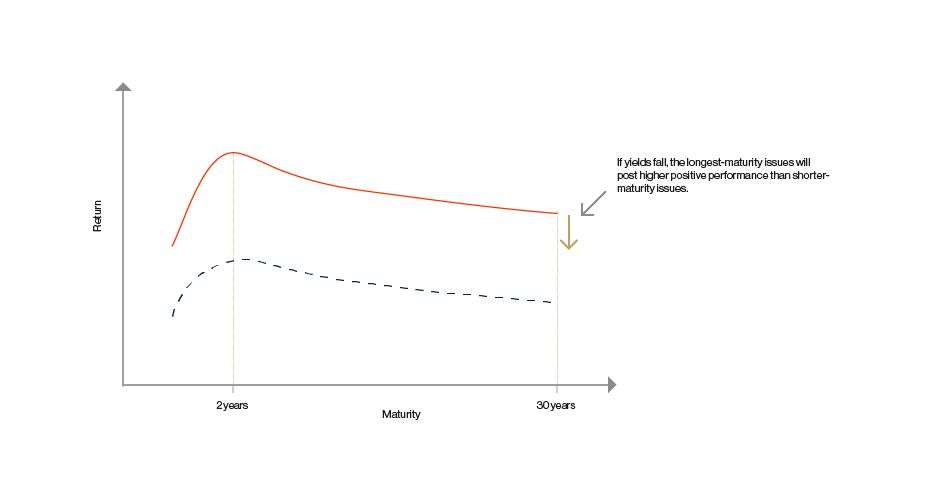
Source: BLI
More generally, formalisation of the notion of risk over the last few decades has resulted in the emergence of new professions in the industry, such as venture capital. According to Ronald Cohen, co-founder of the venture capital fund Apax Partners, the venture capital industry has been able to participate fully in the tech revolution because it systematically factors in risk[4]. As a result, thanks to greater expertise in the risk dimension, capital has been directed more efficiently, paving the way for major innovations and players such as Google and Amazon.
The notion of risk, which might have seemed incongruous or counter-intuitive to investors seeking performance, has in fact gained traction and given rise to improved practices at various levels of the finance industry.
Impact, still an alien concept
The notion of impact is still too little integrated in our industry’s discussions and thinking. In addition to performance and risk, which are currently the main two (and virtually only) dimensions of investment, impact generation should be considered as a third and complementary dimension. It is being increasingly encouraged, if not to say required, in the financial sphere, notably via the SFDR regulation and the EU taxonomy. Although not yet obligatory, businesses in other sectors are also likely to have to indicate the proportion of their activities and investments that are sustainable.
However, the various players in the world of finance, and in particular those in World 2, still find it hard to identify with the impact dimension. Moreover, doubts persist as to the best way to achieve and measure impact.
Asset owners, investors and their advisers can choose to allocate their assets to products, asset classes, issuers and instruments with different levels of expected returns. World 2, as defined above, agrees on the relative attractiveness of issuers such as Eskom and Petrobras, favoured by many of these analysts and investors. A few days ago, the yield on the 2028 issue from South Africa's public utility, Eskom (largest electricity generation and distribution company in South Africa), was almost 12% in dollars[6]. At these levels, the state-owned South African government entity is a compelling opportunity for a bond manager specialising in emerging markets who is thinking solely in terms of risk and return.
However, a growing number of portfolio managers are now being prevented from buying this type of bond because of an SRI policy that very likely excludes an issuer with such negative ESG characteristics. Eskom is on the NGO Urgewald's Global Coal Exist List (GCEL)[7], has 21 controversies on the MSCI ESG platform and a low MSCI ESG rating. The company is also on the Watchlist for compliance with the United Nations Global Compact (UNGC) regarding human rights and labour laws.
This is a case clearly illustrating that (risk-adjusted) return is no longer the only objective in investment.
In practice, investors are not reducing purely financial risks through these exclusions but rather the social and/or environmental risk linked to activities or behaviour that do not respect good social and/or environmental practices.
In addition to the various exclusion factors (GCEL, Controversies, UNGC, etc.), the European Commission and other authorities, as well as increasing numbers of clients, are now encouraging us to include in our portfolios companies whose activities are able to mitigate climate change or work to improve the social conditions of the poorest communities.
In contrast to this example of a rather traditional type of investment where the financial instruments used are relatively liquid (bond issues available on a secondary market), it is interesting to consider issuers offering decentralised solar energy access solutions such as Sun King or Solar Africa whose activities are aligned with some of the Sustainable Development Goals, especially Goal 7 (affordable and clean energy). In this case, the instruments used tend to be the private debt type (with little activity on a secondary market). The criticality of the needs covered by these actors (access to renewable and affordable energy for the poorest communities, financial inclusion, affordable housing, etc.) gives these instruments a relatively resilient character and some decorrelation from financial market fluctuations. The expected returns vary less than for a bond available on a secondary market and for such an investment could be around 7-8% in USD.
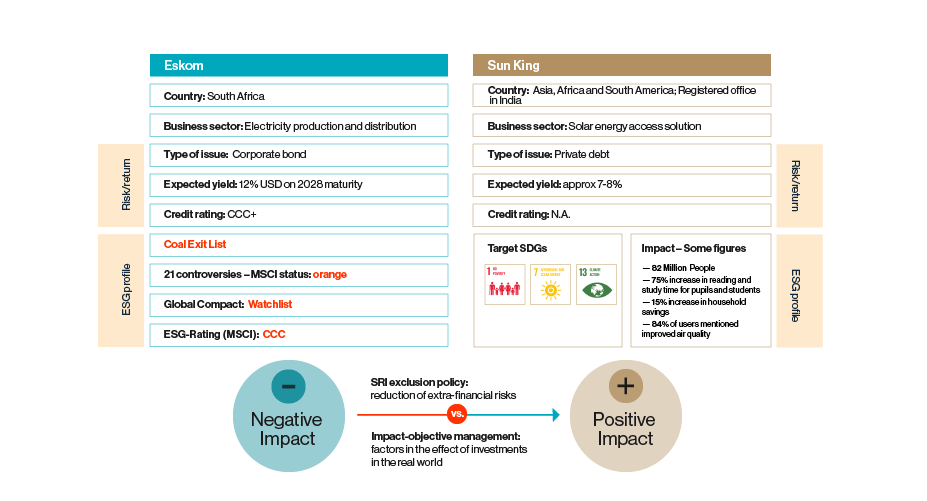
Sources: BLI, SIMA – Social Investment Managers and Advisors, Sun King, MSCI ESG, UNGC, Urgewald
Disparate levels of awareness: bridges must be built between the two worlds
As shown by numerous studies on the subject, there is real awareness of the importance of the impact theme, particularly among asset owners: HNWIs, family offices, foundations, private and retail investors, etc.
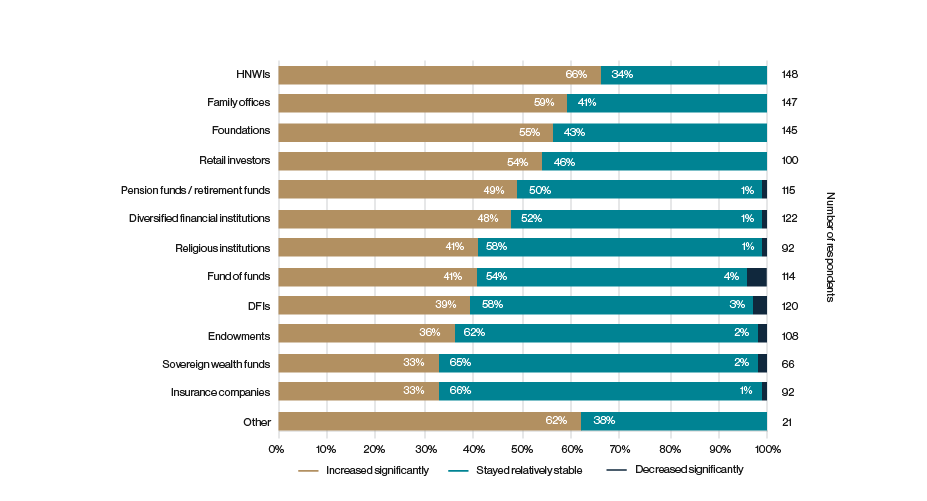
Source: GIIN, 2020 Annual Impact Investor Survey[8]
Younger generations also appear to be showing more interest than their elders. Between 2019 and 2021, Fidelity Charitable published various studies[9] that highlight the gap in understanding impact investing between advisers and their younger clients. While more than 70% of Millennials and affluent Gen-Xers say they have made an impact investment, only 49% of advisers consider that the practice of investing for social or environmental purposes is a long-term trend and only 53% of advisers say they have a good understanding of the subject.
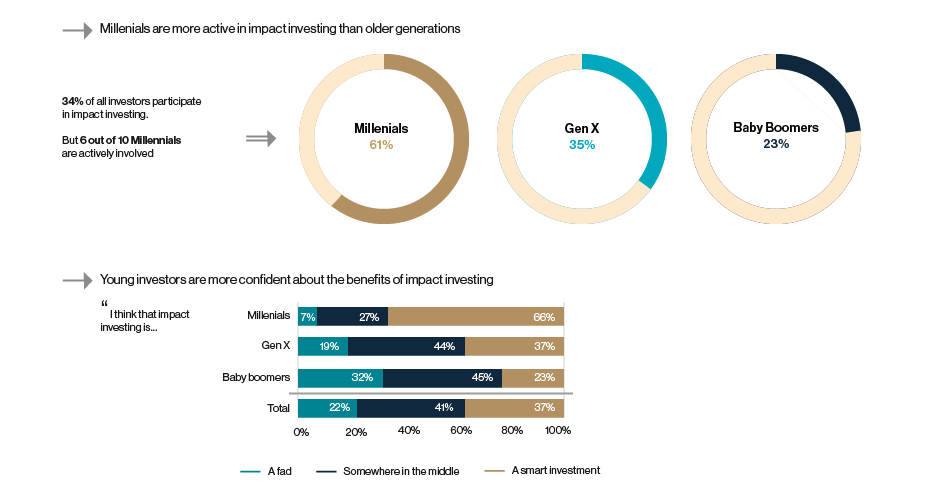
Source: Fidelity Charitable
So the question now is how and to what extent all the actors involved at different levels, from asset owners to portfolio managers to investment advisers, will integrate this dimension into their approach in light of equivalent applications already adopted and practised naturally within the risk dimension.
Collaboration between different industry players (e.g. through blended finance solutions[10]) and beyond that, questions about impact measurement and reporting, are all prerequisites that will make for easier and more effective adoption of this new dimension and a strong commitment from investors to consider such investment solutions.
_____________________
[1] Aswath Damodaran, Stern School of Business, New York University
[2] The Sustainable Development Goals are a call to action for all countries – rich, poor and middle-income – to promote prosperity while protecting the planet. They recognise that ending poverty must go hand in hand with strategies that advance economic growth and address a range of social needs, including education, health, social protection and employment opportunities, while tackling climate change and protecting the environment (website).
[3] When a bond's yield falls (in the context of a slowing economy and falling inflation, for example), its price rises in proportion to the bond's maturity.
[4] COHEN R. (2021). Impact, Reshaping capitalism to drive real change.
[5] COHEN Ronald, op. cit.
[6] ESKOM 8.45% 10/08/2028
[7] NGO that maintains a global coal exit list, i.e. a list of companies involved in the thermal coal value chain (https://www.urgewald.org - https://www.coalexit.org/).
[8] Respondents who have been active in impact investing for less than five years commented on the change in their level of investment since their organisation was founded. The 'Other' category includes government funds, charities and businesses.
[9] “Impact Investing on the Rise: How Financial Advisors are Adapting” and “Using dollars for change - Seven key insights into impact investing for 2022 and beyond”.
[10] Blended Finance: the strategic use of development finance to leverage additional funds for sustainable development in developing countries. Blended finance attracts commercial capital into projects that contribute to sustainable development, while providing financial returns to investors (definition OECD).
[11] COHEN Ronald, op. cit.
Legal notice
This document is a marketing communication. It refers directly or indirectly to one or more financial products (the "Financial Product"). The economic and financial information contained in this publication is provided for information purposes only on the basis of information known at the date of publication. This information does not constitute investment advice, an investment recommendation or a solicitation to invest and should not be understood as legal or tax advice. No warranty is given as to the accuracy, reliability, timeliness or completeness of this information. BLI - Banque de Luxembourg Investments ("BLI") draws the attention of any recipient of this document on the need to use with the utmost caution all information relating to a Financial Product, in particular that relating to the performance of such Financial Product:
- Where applicable, any scenarios relating to future performance in this document are an estimate of such future performance based on evidence from the past on how the value of this Financial Product varies and/or current market conditions. They are not an exact indicator and what you will get will vary depending on how the market performs and how long you keep the Financial Product.
- Conversely, the past performance of the Financial Product does not predict its future returns.
BLI does not assume any responsibility for the future performance of these Financial Products and will not be liable for this information or for any decision that an investor may make based on this information. Interested persons should ensure that they understand all the risks inherent in their investment decisions and should refrain from investing until they have carefully assessed, in collaboration with their own advisors, the suitability of their investments to their specific financial situation, in particular with regard to legal, tax and accounting aspects.
They must, moreover, take into account all the characteristics and objectives of the Financial Product, in particular where it refers to sustainability aspects in accordance with Regulation (EU) 2019/2088 of the European Parliament and of the Council of 27 November 2019 on sustainability reporting in the financial services sector.
Subscriptions are only permitted on the basis of the current prospectus, the latest annual or semi-annual report and the Key Investor Information Document (KIID) (the "Documents"). The Documents are available free of charge from BLI at any time. All of the Documents, including the sustainability information, are available on BLI's website at www.bli.lu.
Any reproduction of this document is subject to the prior written consent of BLI.
Author: Jean Philippe Donge, Head of Fixed Income, info@bli.lu
The author of this document is employed by BLI - Banque de Luxembourg Investments, an asset management company authorised by the Commission de Surveillance du Secteur Financier Luxembourg (CSSF).
Date and time of publication: 25 October 2022, 15:30

